Overview
This page provides advice for bed bug protection in your home, apartment or when traveling. Bed bug protection for the home and apartments can be achieved with a combination of products including bedbug sprays, mattress and box spring covers, and other methods such as sealing cracks and crevices in a room. You can also protect against bringing home bed bugs by following several steps that are outlined below.
If you live in an apartment, and if an adjacent apartment has bed bugs, studies show that there is a 20% chance that bedbugs spread from next door, to a 75% chance that bed bugs spread from an apartment above or below yours.
When traveling, bed bug protection starts with a room inspection. Luggage can also be treated with a luggage bed bug spray before you leave.
bed bug protection for homes and apartments
Preventing Bed Bugs from Entering Your Home
There are many things you can do to protect your home from getting bed bugs:
- Inspect Used Furniture (and sometimes new furniture): Never bring used mattresses, box springs and furniture
(particularly upholstered) into the home unless treated in a heat truck designed to kill bed bugs. Thoroughly inspect rented furniture. Avoid new purchases that are not sealed when transported
with used furniture or mattresses.
- Seal any openings that are between apartments, such as areas with adjoining pipes, seal cracks in the wall, and areas along baseboards. This will help to keep bed bugs from entering your apartment from an adjacent apartment.
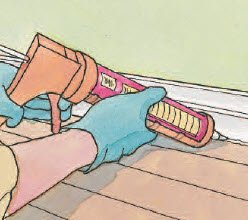 Bed Bug Proection Tip: Caulk any Credit Card Width Gaps to Prevent Bed Bugs from Entering a Room
Bed Bug Proection Tip: Caulk any Credit Card Width Gaps to Prevent Bed Bugs from Entering a Room- Strip off Clothes Before Entering Your Home if Coming from an Infested Area: If you visit a home or office that has bed bugs, when you
return home, take off your clothes at the entry to the home (preferably in a garage). Place all clothes in a
sealed plastic bag, large ziploc bag or plastic bin with a snap on lid. Wash clothes in hot water followed by 30 minutes in a dryer.
- Protect the
Mattress and Box Spring with Covers: Zippered box
spring and mattress covers can keep bed bugs from infesting a
mattress and potentially minimize the number of hiding places. It is
important to buy one that is bed bug proof, as this indicates that it
was specifically tested to prevent bed bugs. Covers can also be
purchased and used after an infestation is discovered to trap and kill
any bed bugs and bed bug eggs. While some home
owners don't cover the box spring, it is important as it can provide
more hiding places than the mattress. Covers do not prevent bed bugs,
but will keep your mattress usable if you suspect an infestation.
- Place Climbup
Interceptors Under Each Bed Leg: Climbup
Interceptors are inexpensive bed bug
traps that will catch any bed bugs that approach and try to move onto
the bed via the legs. They are also an excellent monitor to determine if
you have bed bugs at all or to judge if an infestation is large or
being reduced.
Along with the Climbup traps, to minimize the ability of bed bugs to climb onto the bed, keep linen off the floor and keep the bed at least 6 inches from any furniture including end tables.
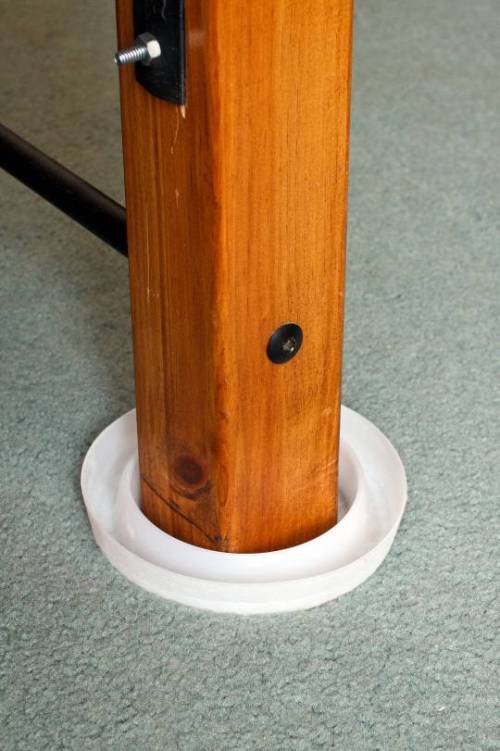 Place a Climbup Trap under bed legs to confirm the problem is gone after treatment (bowl will stay empty for 2 to 3 weeks), & to see the size of the infestation.
Place a Climbup Trap under bed legs to confirm the problem is gone after treatment (bowl will stay empty for 2 to 3 weeks), & to see the size of the infestation.- Dispose of Clutter: Eliminate clutter to minimize the number of bed bug hiding places. This includes books and magazines.
- Tighten Cable and Electrical Plates: Bed bugs can hide just enter plates that are screwed onto the wall.
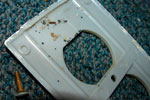 Bed Bug Tip: Tighten Electrical Plates to Eliminate Area as a Bed Bug Hiding Place
Bed Bug Tip: Tighten Electrical Plates to Eliminate Area as a Bed Bug Hiding PlaceTreatment and Prevention Kits
Bed bug treatment requires the use of multiple products:
- Knock down spray to kill the insects and eggs on contact. Make sure spray is mattress safe.
- Residual spray to create an invisible barrier to kill any bed bugs that pass through the barrier. It is easy to miss bed bugs or to kill any hiding in the walls during the first treatment.
- Bed bug dust that also creates a barrier. It kills by clinging to the bed bug.
- Mattress and box spring covers (to trap any bed bugs inside the mattress or box spring that were not killed during treatment). Also keeps new insects out.
The best way to buy the two sprays and dust is to purchase a bed bug kit. Covers can be purchased from Amazon.
traveling
There are some simple things you can do to avoid bringing bed bugs home with you when traveling.
Inspect the hotel room mattress: The majority of bed bugs cluster around the mattress while waiting for a human host. Before bringing your luggage into a room, peel back the blankets and sheets and inspect along the mattress seams. A clean mattress like the one shown below means no bed bugs. Red spots, molted skins or fecal matter (see 2nd picture below) means that the room probably has a bed bug problem.
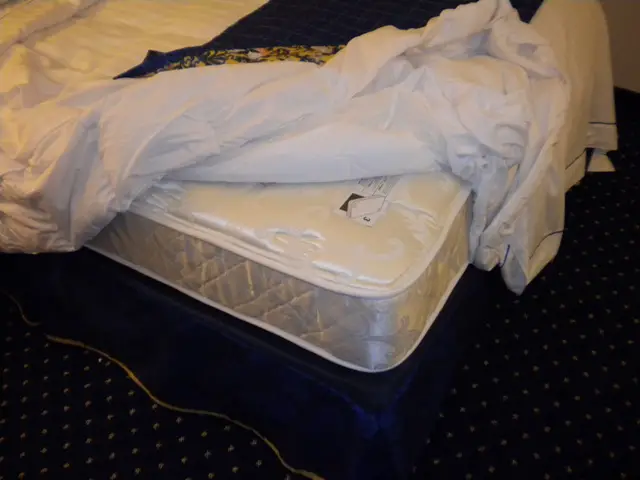 This is a spot free mattress and therefore bed bug free. There are no stains along the seams.
This is a spot free mattress and therefore bed bug free. There are no stains along the seams.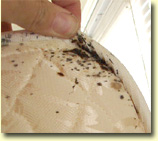 Example #1: Fecal Stains on a Mattress, a sign of a Bed Bug Problem
Example #1: Fecal Stains on a Mattress, a sign of a Bed Bug Problem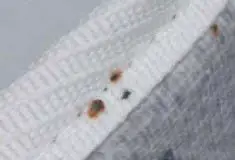 Example #2: Bed Bug Fecal Stains on Mattress
Example #2: Bed Bug Fecal Stains on MattressBed Bug Luggage Protection Instructions
- Pack clothes in a Ziploc big bag or protect your luggage in the room with the bag. Pack another Ziploc bag for dirty clothes. Bring bagged clothes directly to washing machine or dry cleaner when returning home.

- Travel with a hard sided suitcase. There are fewer places for bed bugs to hide on the surface of the case.
- Do not place clothes in a hotel room drawer. Hang clothes on the bathroom shower bar.
- Keep your luggage elevated and away from the walls.
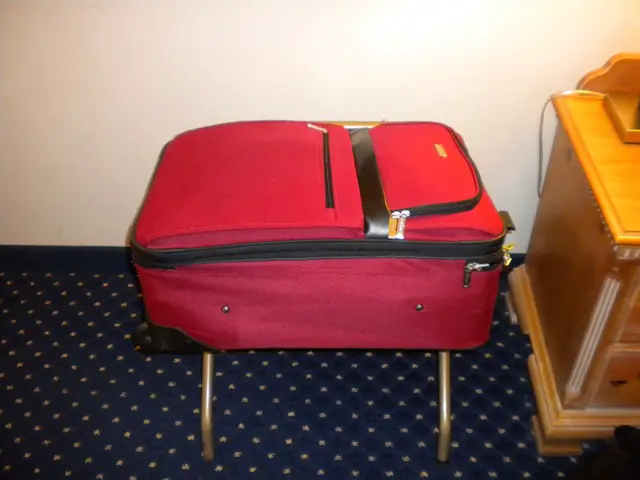 Bed Bug Travel Tip: Keep Luggage Elevated and Away From Walls and Furniture. Keep Luggage Zipped at All Times.
Bed Bug Travel Tip: Keep Luggage Elevated and Away From Walls and Furniture. Keep Luggage Zipped at All Times.car protection
We receive many letters from readers such as social workers who are often providing transportation to low income individuals that may have had a bed bug problem. They are concerned that bed bugs will spread to their car.
The odds are fairly low for this to happen as a female impregnated bed bed would have to have hid in a piece of luggage or on clothing, and then would have to move into the car and then onto an object or clothing by the driver.
However, a simple precaution would be to spray the car with a low cost
residual
spray which has been independently verified to show no bed bug
resistance such as Bedlam.
Tips for landlords and building managers
The most important step in a bed bug protection program for an
apartment is education. This includes:
- Development of a written bed bug policy and guidelines for apartment tenants so there is no shame, mystery or ambiguity around who will pay for treatment.
- Open policy where bed bugs are reported immediately so that infestations can be treated early.
- When bed bugs are reported, all apartments that are above, below and next to the infested unit are inspected and treated.
- A building manager should call in a experienced professional such as someone certified by Home Advisor for a free on-site inspection and assessment. They can also call (877) 673-2704 for a recommendation.
- Before treatment, educate tenants on the need to eliminate clutter, move furniture away from walls and any safety issues for children and pets. Offer to help older tenants move furniture and remove clutter from the apartment.
- Inform tenants before treatment begins and provide product names and safety information.
- Publish the plan for follow up inspections.
- Plan for tenants that do not speak or understand English by providing translations of all materials provided.
- Inspect apartments before renting and treat if necessary.
brochures
Review these brochures for more information on how to protect yourself and your family from bed bugs at home and when traveling.
questions and answers
Ask a Question or Share Your Bed Bug Experience With Others
Do you have a question or great story about bed bugs? Share it!
